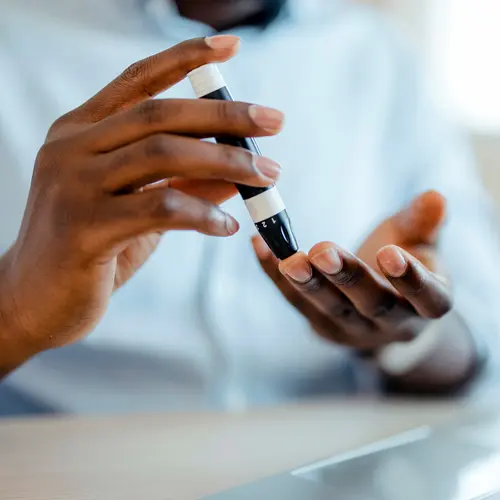Diabetes makes you more likely to have sores and ulcers. Ulcers are open sores (also referred to as wounds) on your skin that don’t heal the way they should. You’re most likely to get ulcers in your feet and legs, but they can also form in other areas, like your hands or in folds of skin on your stomach.
There are several reasons why diabetes raises your odds of getting ulcers. One of the main symptoms of diabetes is high blood sugar (also called blood glucose). Over time, high blood sugar levels can damage your nerves and blood vessels. That lessens blood flow (especially to your hands, feet, and limbs), which makes it harder for sores and cuts to heal. It makes you more likely to get an infection, too. What’s more, diabetes is linked to a condition called peripheral arterial disease (PAD), which lessens blood flow to your legs and feet.
Nerve damage also makes it harder for you to feel pain or other symptoms of ulcers or infections. That can keep you from treating smaller wounds before they become ulcers.
Ulcers are dangerous because they can lead to serious infections or even gangrene, which is when your tissue dies. In some cases, the only way doctors can treat the infection or gangrene is to amputate the affected area.
How to Treat Ulcers
If you do get an ulcer or notice a change in your skin that you’re not sure about, tell your doctor right away. You’ll likely get a procedure called debridement, which removes unhealthy tissue from the wound to spur healing.
Your doctor will also work with you to try to keep your sore or ulcer from getting infected and becoming bigger. Some of the steps they may recommend include:
Clean your ulcer daily. Use soap and water, unless your doctor recommends another cleanser. Don’t use hydrogen peroxide or soak your wound in a bath or whirlpool, because this could reduce healing and may boost your odds of infection.
Keep your ulcer bandaged or covered with a wound dressing. (Your doctor may recommend specific bandaging steps depending on the location of your ulcer.) While you may have heard that it’s important to “air out” wounds, experts now know that not covering a wound actually increases the odds of infection and slows healing.
Keep pressure off your ulcer, especially if it’s on your foot. This may mean you need to use crutches, special footwear, a brace, or other devices. Reducing pressure and irritation helps ulcers heal faster.
Use the topical medications your doctor recommends. (“Topical” means that the medication goes on your skin.) These may be saline, growth factors, and/or skin substitutes.
Keep your blood sugar under control. In addition to reducing your risk of ulcers, tight blood sugar control helps your body heal existing ulcers.
When You Need More Treatment
If your wound doesn’t heal in about a month or becomes an infection that spreads to the bone, you may need other treatments. These can include surgery (most often to remove pressure-causing problems, such as bunions) and hyperbolic oxygen therapy, which involves breathing pure oxygen in a special room in order to help your body heal.
If your ulcer develops gangrene and your tissue dies, your doctor may have to amputate (surgically remove) that area of your body.
Tips to Prevent Ulcers
There’s a lot you can do to lower your chance of having ulcers in the first place:
Keep your blood sugar in check. Good blood sugar control is the single best way to prevent small cuts and sores from becoming ulcers. If you have trouble managing your blood sugar, tell your doctor. They can work with you to make changes to your medication and lifestyle that will keep your blood sugar from getting too high. Even if your blood sugar level is fairly steady, it’s still important to see your doctor regularly. That’s especially key if you have neuropathy, because you may not feel damage to your skin and tissue.
Check your skin every day, and pay special attention to your feet. Look for blisters, cuts, cracks, sores, redness, white spots or areas, thick calluses, discoloration, or other changes. Don’t rely on pain; even feeling more warmth or cold than usual can be a sign that you have an open wound on your skin, and it’s possible that you may feel nothing at all.
Ulcers are most likely to form on the ball of your foot or the bottom of your big toe, so be sure to check your feet every night. (Ask a family member to help you if you can’t check on your own.) If you notice a problem, or you aren’t sure if something’s normal, call your doctor.
Don’t smoke. Smoking damages your blood vessels, decreases blood flow, and slows healing. Those things raise your risk of ulcers and amputation.
Don’t walk barefoot. Injuring your toes or foot can raise your chances of serious problems. Wearing shoes that cover your whole foot can help prevent injury. Medicare and health insurance may cover prescription shoes that lessen your risk of foot sores.

